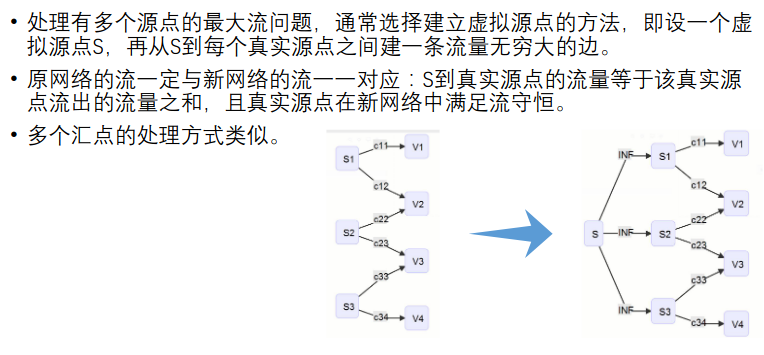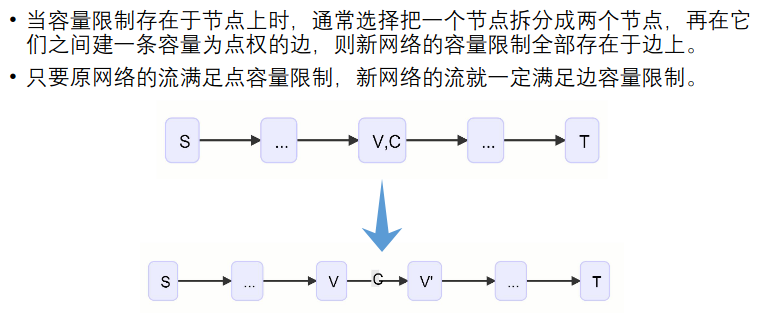网络流1
-A.板子
从“课本”上贺的。
code
#include <bits/stdc++.h>
using namespace std;
typedef long long ll;
const int maxn = 1e3 + 2;
const int maxm = 1e5 + 3;
const int inf = 1 << 29;
//const int mod = 1e9 + 7;
int n, m, s, t, tot, maxflow;
int d[maxn], now[maxn];
queue<int> q;
struct node
{
int to, nxt, w;
}a[maxm<<1];
int len, head[maxn];
void add(int x, int y, int w)
{
a[++len].to = y; a[len].w = w; a[len].nxt = head[x]; head[x] = len;
a[++len].to = x; a[len].w = 0; a[len].nxt = head[x]; head[x] = len;
}
bool bfs()
{
memset(d, 0, sizeof(d));
while(q.size()) q.pop();
q.push(s); d[s] = 1; now[s] = head[s];
while(q.size())
{
int x = q.front(); q.pop();
for(int i=head[x]; i; i=a[i].nxt)
{
if(a[i].w && !d[a[i].to])
{
q.push(a[i].to);
now[a[i].to] = head[a[i].to];
d[a[i].to] = d[x] + 1;
if(a[i].to == t) return 1;
}
}
}
return 0;
}
int dinic(int x, int flow)
{
if(x == t) return flow;
int rest = flow, k, i;
for(i=now[x]; i&&rest; i=a[i].nxt)
{
now[x] = i;
if(a[i].w && d[a[i].to] == d[x]+1)
{
k = dinic(a[i].to, min(rest, a[i].w));
if(!k) d[a[i].to] = 0;
a[i].w -= k;
a[i^1].w += k;
rest -= k;
}
}
return flow - rest;
}
int main()
{
scanf("%d%d%d%d", &n, &m, &s, &t);
len = 1;
for(int i=1; i<=m; i++)
{
int u, v, c; scanf("%d%d%d", &u, &v, &c);
add(u, v, c);
}
int flow = 0;
while(bfs())
while(flow = dinic(s, inf)) maxflow += flow;
printf("%d", maxflow);
return 0;
}A. 蜥蜴
我坚信我背的板子是对的,结果我记错了,k = dinic(y, min(rest, a[i].w)被我记成了和flow取min……
对建反向边理解还不深刻,有的边反向了有的边没反向,还把源点到蜥蜴全都连成了inf,事实上应该连1,因为最大流答案不能超过蜥蜴总数,有蜥蜴的石柱上只有一只,没有更多的能逃出去。
网络流的第一个题,充分表现出Cat啥都没学会***



#include <bits/stdc++.h> using namespace std; typedef long long ll; const int maxn = 100019; const int N = 505; const ll mod = 1e9 + 7; const int inf = (1<<29); int num, D, lenx, leny, mp[190][190], maxflow, L[190][190]; queue<int> q; char s1[maxn]; int s, t, tot, d[maxn]; struct node2 { int x, y, dis; }c1[N]; inline int read() { int x = 0, f = 1; char ch = getchar(); while(ch < '0' || ch > '9') { if(ch == '-') { f = -1; } ch = getchar(); } while(ch >= '0' && ch <= '9') { x = (x << 1) + (x << 3) + (ch^48); ch = getchar(); } return x * f; } double getdis(int x1, int y1, int x2, int y2) { return ((x1-x2)*(x1-x2)+(y1-y2)*(y1-y2)); } int getindex(int x, int y) { return (x-1)*leny + y; } struct node { int next, to, w; }a[maxn<<2]; int head[maxn], len=1, now[maxn]; void add(int x, int y, int w) { a[++len].to = y; a[len].next = head[x]; a[len].w = w; head[x] = len; } bool bfs() { memset(d, 0, sizeof(d)); while(q.size()) q.pop(); q.push(s); d[s] = 1; now[s] = head[s]; while(q.size()) { int x = q.front(); q.pop(); for(int i=head[x]; i; i=a[i].next) { int y = a[i].to; if(a[i].w && !d[y]) { q.push(y); now[y] = head[y]; d[y] = d[x] + 1; if(y == t) return 1; } } } return 0; } int dinic(int x, int flow) { if(x == t) return flow; int rest = flow, k, i; for(i=now[x]; i && rest; i=a[i].next) { now[x] = i; int y = a[i].to; if(a[i].w && d[y] == d[x] + 1) { k = dinic(y, min(rest, a[i].w)); if(!k) d[y] = 0; a[i].w -= k; a[i^1].w += k; rest -= k; } } return flow - rest; } int main() { lenx = read(); leny = read(); D = read(); for(int i=1; i<=lenx; i++) { scanf("%s", s1+1); for(int j=1; j<=leny; j++) { mp[i][j] = s1[j]-'0'; } } for(int i=1; i<=lenx; i++) { scanf("%s", s1+1); for(int j=1; j<=leny; j++) { if(s1[j] == 'L') { L[i][j] = 1; num++; } } } tot = lenx * leny; s = tot * 2 + 1; t = s + 1; for(int i=1; i<=lenx; i++) { for(int j=1; j<=leny; j++) { int I = getindex(i, j); if(mp[i][j]) { add(I, I+tot, mp[i][j]); add(I+tot, I, 0); if(i+D>lenx || i-D<1 || j+D>leny || j-D<1) { add(I+tot, t, inf); add(t, I+tot, inf);//反向也有边权是因为t既是入点又是出点 } } if(L[i][j]) { add(s, I, 1);//最大流答案不能超过蜥蜴总数 add(I, s, 0); } } } for(int x1=1; x1<=lenx; x1++) { for(int y1=1; y1<=leny; y1++) { for(int x2=1; x2<=lenx; x2++) { for(int y2=1; y2<=leny; y2++) { if(getdis(x1, y1, x2, y2) <= D * D) { int u = getindex(x1, y1), v = getindex(x2, y2); add(u+tot, v, inf);//出点连入点 add(v, u+tot, 0); add(v+tot, u, inf); add(u, v+tot, 0); } } } } } int flow = 0; while(bfs()) { while(flow = dinic(s, inf)) maxflow += flow; } printf("%d\n", num - maxflow); return 0; }
B. 星际战争
既然放在了最大流的分区,那就联想一下和最大流的关系,要不是因为专题我绝对联想不到最大流:
思路1.把n和m都拆成两个点,两个点中间的边权就是装甲值或攻击强度,然后求出来的最大流就是单位时间的有效进攻量,再用总数除以这个最大流。然后忽然发现这样被攻击的点有的满了有的没满,所以用总数直接除是错的……
思路2.n还是一个点,把m拆了,源点到n和n到m的入点都是inf,然后算出最大流的情况下1~n每个点流出的流量,再分别除以B[i],emmm似乎有一点点道理的样子……
不过以上都不是正解,正解是二分答案,每一次二分重新建图,激光武器的边权改成t*B[i],判断总流量能否达到A[i]的和。而且,这道题居然并不需要拆点。
鹤一篇题解??算了改天再鹤……
upd:
关于会记错板子这件事,我认为是没学会,所以打算重学。
打算从EK开始。
code
//叩首问路,码梦为生
#include <bits/stdc++.h>
using namespace std;
typedef long long ll;
const int maxn = 1e5 + 3;
void add(int x, int y, int z)
{
}
bool bfs()
{
memset(v, 0, sizeof(v));
queue<int> q;
q.push(s); v[s] = 1;
incf[s] = inf;
while(q.size())
{
int x = q.front(); q.pop();
for(int i=head[x]; i; i=a[i].nxt)
{
if(a[i].w)
{
int y = a[i].to;
if(v[y]) continue;
incf[y] = min(incf[x], a[i].w);
pre[y] = i;
q.push(y), v[y] = 1;
if(y == t) return 1;
}
}
}
return 0;
}
void update()
{
int x = t;
while(x != s)
{
int i = pre[x];
a[i].w -= incf[t];
a[i^1].w += incf[t];
x = a[i^1].to;
}
maxflow += incf[t];
}
int main()
{
while(cin >> m >> n)
{
memset(jead, 0, sizeof(head));
s = 1, t = n; tot = 1; maxflow = 0;
for(int i=1; i<=m; i++)
{
int x, y, c; scanf("%d%d%d", &x, &y, &c);
add(x, y, c);
}
while(bfs()) update();
cout << maxflow << endl;
}
return 0;
}
时光花火,水月星辰



 浙公网安备 33010602011771号
浙公网安备 33010602011771号